New Book Releases / Winter 2024
If you would like to alert us to a recent or forthcoming film publication for the next round-up in winter, please contact us here. For notes on more books, see David Hudson’s monthly round-up at Criterion’s The Daily.
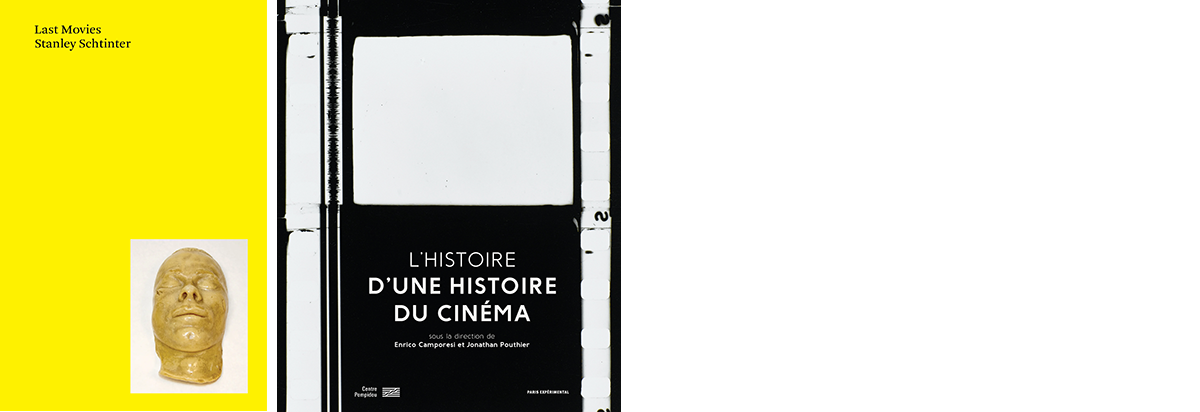
The end is the beginning is the end. In Last Movies (A Book of Endings), the artist and curator Stanley Schtinter looks at the last film that twenty-eight twentieth-century political and cultural figures had watched, bringing together a potted history of the medium itself. Here, we have a book in which Manhattan Melodrama, directed by W. S. van Dyke and George Cukor, is seen by the American gangster John Dillinger, only for him to be gunned down by federal agents upon leaving the cinema. In which George Cukor watched The Graduate and dies thereafter. In which Bette Davis – given her break by Cukor – watches herself in Waterloo Bridge (the 1940 remake Cukor had been meant to direct) before travelling to France and failing to make it back to Hollywood. In which Rainer Werner Fassbinder watches Bette Davis in Michael Curtiz’s 20,000 Years in Sing Sing and suffers the stroke that kills him. In which John F. Kennedy watches From Russia with Love at a private screening prior to the presidential motorcade reaching Dealey Plaza. In which Burt Topper’s War is Hell exists only in a fifteen-minute cut, considering this is as much as Lee Harvey Oswald would have seen at the Texas Theatre in the wake of JFK’s killing. And what are we meant to understand from learning that Franz Kafka’s last movie was The Kid by Charlie Chaplin (whose final film was Stanley Kubrick’s Barry Lyndon)? Published by Tenement Press last November, the book also just became available as a glow-in-the-dark hardback edition in a very limited run from Schtinter’s anti-record label purge.xxx. The French scholar and programmer Nicole Brenez wrote the last word(s).
The author of the foreword and programme notes of the former book, Erika Balsom, also contributed to L’histoire d’une histoire du cinema. This collection retraces a political and cultural history of the 1976 landmark exhibition “Une histoire du cinema” (A History of Cinema) including about three hundred avant-garde films. A facsimile of the original catalog is juxtaposed with a set of unpublished documents, new texts, period publications and interviews with Annette Michelson and Peter Kubelka who together conceived this Paris exhibition commissioned by Pontus Hultén, the future first director of the Centre Pompidou. The latter institution co-published the collection last month together with Paris Experimental.
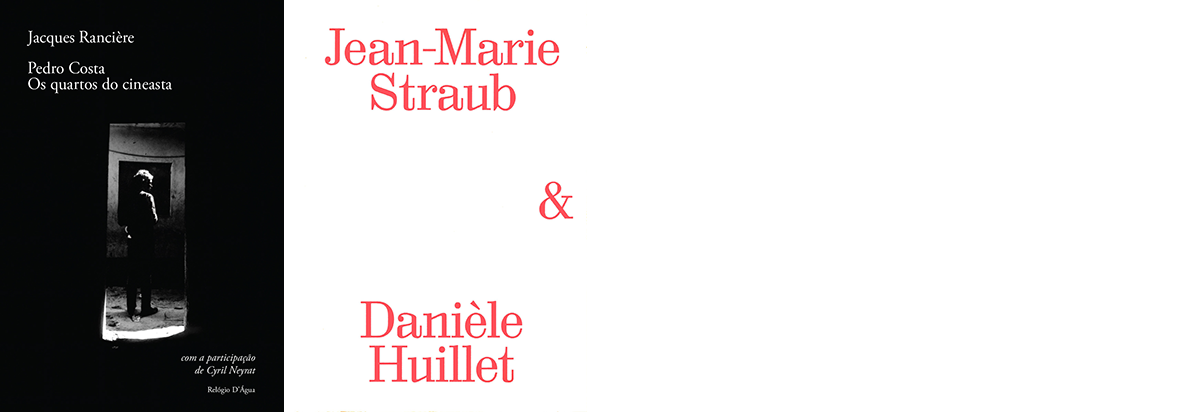
To accompany the exhibition dedicated to the work of Jean-Marie Straub and Danièle Huillet running until the end of March at Casa do Cinema Manoel de Oliveira, the Serralves Foundation published a bilingual catalogue (EN/PT) featuring especially commissioned essays. These are complemented by two reprinted texts by the actress and Straub’s collaborator Barbara Ulrich Straub and the author and film historian Santos Zunzunegui. Jean-Marie & Danièle Huillet: In the Crater of the Volcano is completed with the transcription of a 1975 conversation that brought together Jean-Marie Straub, Danièle Huillet, Marcel Hanoun, Robert Kramer and Manoel de Oliveira. Please take note that the Danish film journal Balthazar also dedicated its latest, bilingual issue (DK/EN) to Huillet and Straub and that it’s available to read in its entirety online. Last October, Sabzian published a selection of texts from the issue.
The latter issue includes a new interview with the Portuguese filmmaker Pedro Costa about Huillet and Straub and the 2001 film he made about their work process, conducted by Oscar Pedersen last April in Lisbon. Meanwhile, the new collection Pedro Costa: Os quartos do cineasta brings together the five articles that the French philosopher and critic Jacques Rancière dedicated to Costa’s cinema, the filmmaker’s conversations with the French author Cyril Neyrat around selected film fragments and three public debates between Rancière and Costa. Published last November, the collection is available from Relógio d’Água. Rancière’s texts on Vitalina Varela (2019), Cavalo dinheiro (2014) and the politics of Costa are available on Sabzian in French, Dutch and/or English, just as Neyrat’s conversation with Costa on In Vanda’s Room (2000).
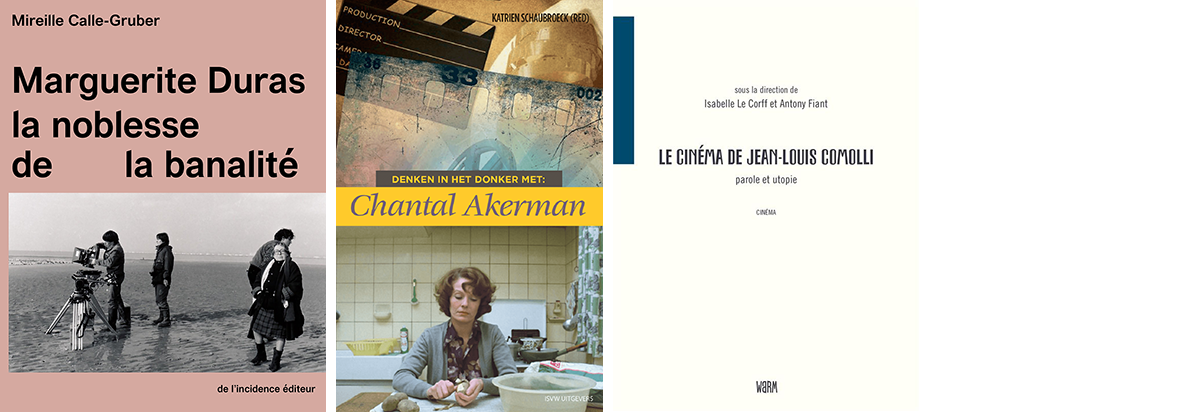
Last November, De L’incidence éditeur issued a second, revised edition of Marguerite Duras: La noblesse de la banalité, originally published in 2014. With new chapters, the book is a reflection on the literary transposition of the invisible and banality in the work of the French author and filmmaker. Mireille Calle-Gruber examines the aspect of “seeing” in Duras’s work, as well as the particular tone that characterizes her writing.
The latter book’s focus on the depictions of mundane everyday life and the treatment of the silent, hidden, domestic life of women is something Duras shares with the Belgian filmmaker Chantal Akerman, who found an early supporter in her. Announced in our book note of fall 2022, the Dutch book series Denken in het donker (Thinking in the Dark) continues to release new collections that look at a filmmaker’s work from a philosophical perspective. The edition on Chantal Akerman will hit the shelves in February. Including contributions by the philosophers Petra Van Brabandt, Dominiek Hoens, Karel Pletinck and Michaël Van Remoortere, Denken in het donker met Chantal Akerman will already be the sixth volume in the series after collections on Richard Linklater, Andrei Tarkovsky, the Coen brothers, Sofia Coppola and Agnes Varda (forthcoming in January).
What’s more, back in July 2021 we announced that “L’Arachnéen will publish the writings of Chantal Akerman (about 1500 pages), edited by Cyril Béghin.” Chantal Akerman - Oeuvre écrite et parlée now has a title and a publication date: March 15! It will be presented in the form of three volumes brought together in a box set: two chronological volumes (1968-1991 and 1991-2015) strictly devoted to Akerman’s texts, including screenplays (half of which are for unrealized films), synopses, notes of intent, texts for the voice-overs, preparatory and set photographs, but also interviews, working documents, all essentially unpublished. They will also include four works she published: the theatre play Halle de nuit (1992), two novels, Une famille à Bruxelles (1998) and Ma mère rit (2013), and the autobiography, Le Frigidaire est vide. On peut le remplir (from Autoportrait en cineaste, 2004). The third volume will take the form of a critical edition by the editor Cyril Béghin with a chronology and detailed notes for each of Akerman’s texts, as well as annexes (filmography, list of installations and bibliography). Here, you can leaf through the table of content of the three volumes and get a glimpse of the cover. The publication of Oeuvre écrite et parlée will coincide with numerous events from March onwards: the major exhibition ‘Chantal Akerman: Traveling’ at BOZAR, Brussels (March 14 - July 21), a full retrospective at the Belgian CINEMATEK, as well as numerous initiatives, screenings, readings and talks in both institutions but also at Cinema Palace and RITCS in Brussels. In response, Argos Brussels will stage a group exhibition ‘I put my t-shirt on backwards: à la recherche de Chantal Akerman’ (September 7 - January 6). At the end of September, an adapted version of the BOZAR exhibition will move to Jeu de Paume in Paris, accompanied by a complete retrospective by Capricci.
In reverse, Jean-Louis Comolli generally gets more attention for his writings than his work as a director, although he made more than fifty films between 1959 and 2019. The publishing house WARM now comes with a publication that looks into his cinema. In his comprehensive obituary published on Sabzian, Daniel Fairfax wrote that Comolli’s ten-part series Marseille contre Marseille will inevitably be regarded as his magnum opus and a unique endeavor in the history of film by one of the great filmmaker-theorists. Edited by Antony Fiant and Isabelle Le Corff, Le cinéma de Jean-Louis Comolli: parole et utopie will be out next February.
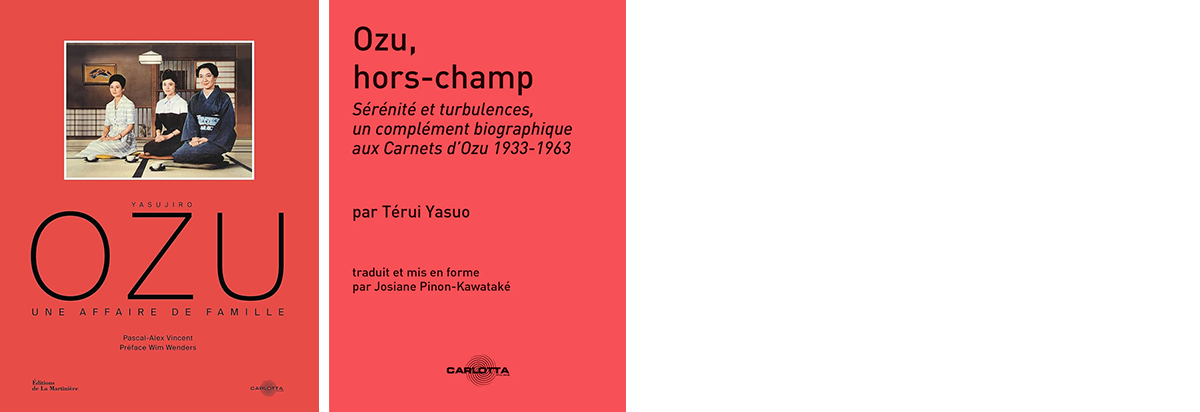
Last October, two new publications on the Japanese filmmaker Yasujiro Ozu have been published by or in collaboration with Carlotta Films. In Yasujiro Ozu: une affaire de famille, the Japanese film expert Pascal-Alex Vincent considers his filmography in which the theme of family is at the heart and to which his own Ozu-gumi (the Ozu clan) was essential. The second book offers another look at the oft-neglected turbulence, whether professionally, intimately or in the family, which Ozu had to face in his life. Complementing Carlotta’s 2020 reissue of Carnets d’Ozu (Ozu’s Diaries), Ozu, hors-champs is a translation of the 2013 biography of the filmmaker written by the Japanese journalist Térui Yasuo. His knowledge of the extensive bibliography devoted to Ozu in Japan offers new information to non-Japanese readers.
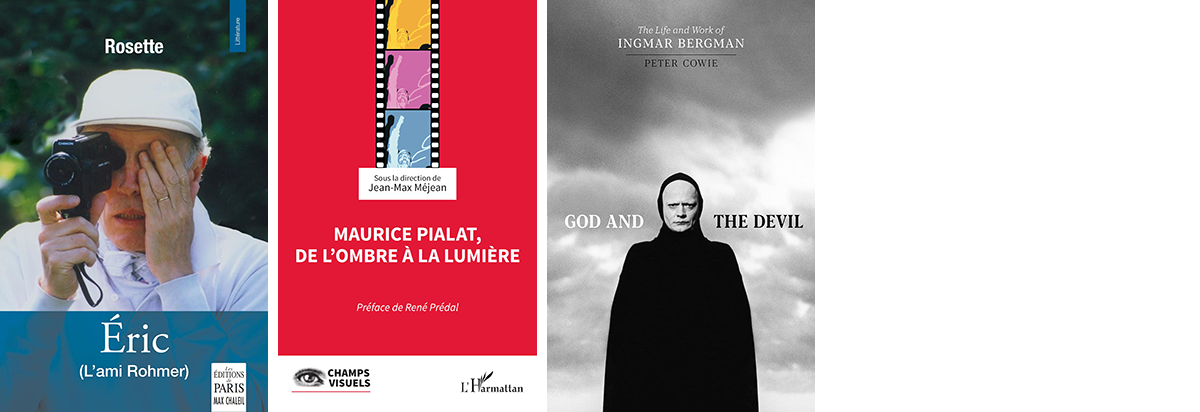
Not a biography per se but an intimate and literary memoir, Eric (L’ami Rohmer) is an account by the actress Rosette of her friendship with the filmmaker Eric Rohmer from their first encounter to his final disappearance. Told in a thematic manner (Thee, Music, Painting, The Rohmériennes, etc.), each chapter opens with an image of Rohmer alone, or with Rosette, opposite to each other, whether during filming or in everyday life, and sometimes it is simply an object (a drawing, photo, painting) directly related to the story. Rosette appeared in six of Rohmer’s films and directed seven short films under his aegis. This cycle of shorts – dubbed The Adventures of Rosette – was screened by Mezzanine last November in Los Angeles in the presence of Rosette to already celebrate the memoir ahead of its publication from Les éditions de Paris this month.
The work of one of Rohmer’s younger colleagues is the object of study in Maurice Pialat, De l’ombre à la lumière. Published by L’Harmattan this month, this collection brings together four critics: Jean-Max Méjean, Alexis Leroy, Hugo Dervisoglou and Jean-Michel Pignol, and it includes a foreword by the critic and emeritus professor René Prédal.
The importance of the Swedish filmmaker Ingmar Bergman to the French (Post) New Wave is well known. It was Rohmer who adopted him with an article in Cahiers du cinéma in 1956. Pialat channeled Bergman in films such as La gueule ouverte (1974) and Sous le soleil de Satan (1987). God and the Devil: The Life and Work of Ingmar Bergman is a new biography of Bergman, the first in forty years, written by Peter Cowie whose own, previous Ingmar Bergman: A Critical Biography dates back to 1982. Having met Bergman in 1969 and corresponded with him until 1995, Cowie blends biographical information with critical comment. Containing exclusive extracts from workbooks and letters, the book was published by Faber & Faber last November.
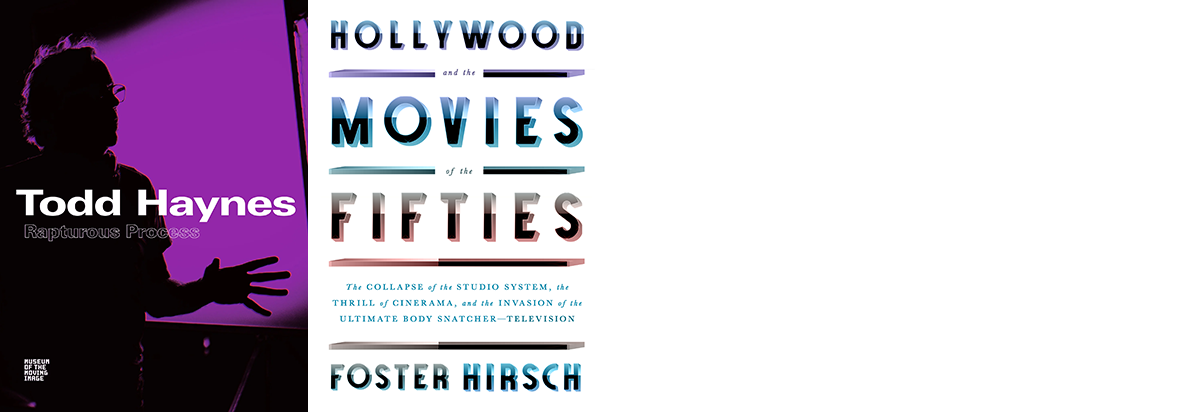
Another veteran film author, Foster Hirsch completed an epic historical account of Tinseltown’s most turbulent decade, the demise of the studio system and the movies that reflected these seismic shifts. His much-praised survey, Hollywood and the Movies of the Fifties, was published by Knopf last October.
“When Foster Hirsch is passionate about a movie, such as Douglas Sirk’s Imitation of Life (1959), his fervor is matched by eloquence and an eye for detail. Indeed, his chapter on melodramas, with its long discussion of Sirk’s extraordinary run of them, is the most moving part of the book,” Richard Brody wrote in The New Yorker. The affinity for 1950s melodrama is evident in Todd Haynes’s Carol (2015) and his Sirk homage Far From Heaven (2002). Todd Haynes: Rapturous Process, published last November by the Museum of the Moving Image, is an adaptation of the Centre Pompidou’s book published on the occasion of its own Haynes retrospective earlier in 2023, but with new material for English-language readers. It includes an in-depth career interview with Haynes by the Pompidou’s Judith Revault d'Allonnes, a new essay by Michael Koresky, a conversation about May December (2023) between Haynes and filmmaker Kelly Reichardt and a foreword by Julianne Moore. The book features more than two hundred pages of materials from Haynes’s archives which the museum has acquired, including drawings, paintings, storyboards, notes, on-set photographs, costume and set designs and more.
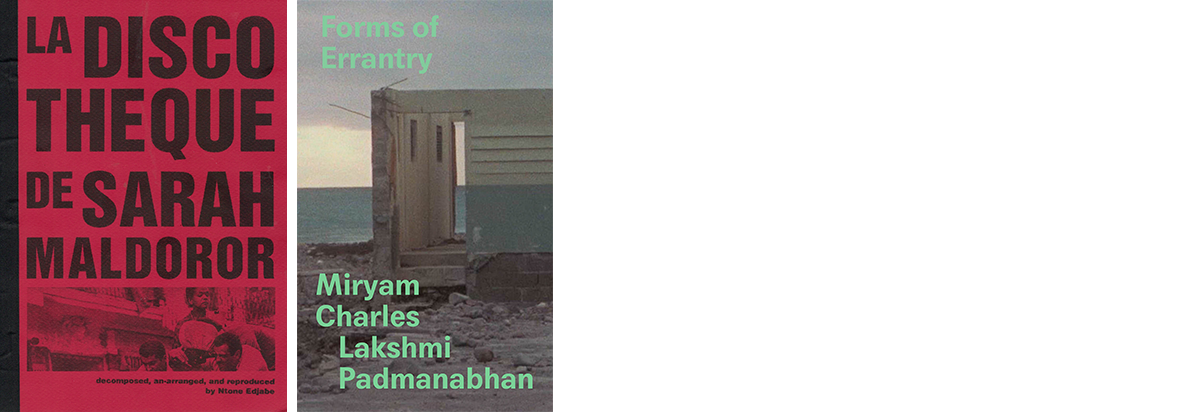
Last month, Light Industry and Alfreda’s Cinema in New York hosted a book launch for Ntone Edjabe’s La Discothèque de Sarah Maldoror, a volume that “takes the form of a mixtape on the soundworld” of the legendary anti-colonial filmmaker. Released by the South African publisher Chimurenga as part of their Chimurenganyana series, this volume is written as a set of poetic annotations to various tracks, illustrating and commenting upon the biographical episodes and political contexts that shaped her work. On the website, you can listen to the audio accompaniment.
The Haitian-Canadian filmmaker Miryam Charles (This House, 2022) lent her voice to Pour Sarah Maldoror: In Memoriam (2020, 7’). In Forms of Errantry, Miryam Charles and the Chicago-based writer and academic Lakshmi Padmanabhan ask how the form of experimental documentary can address the legacies of colonization as they are lived today. Forthcoming early this year from Union Docs, this booklet follows the routes opened up by this question to explore histories of survival and the aesthetics of errantry. Contributors offer poetic responses explored in the fissures between image and sound, personal narrative and political history.
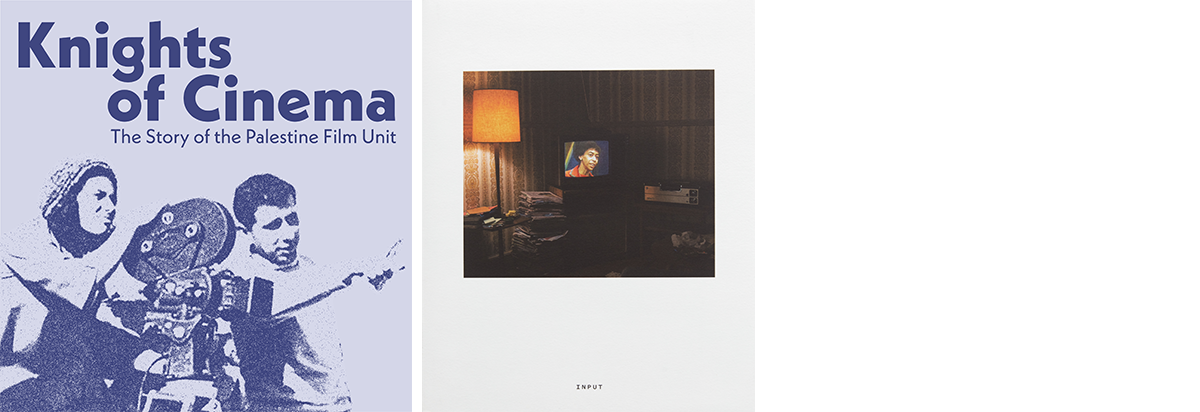
Marion Stokes (1929-2012) was an African American civil rights activist who recorded television twenty-four hours a day for thirty years to make an unprecedented archive of the media. Matt Wolf’s film Recorder (2019) tells her unexpected life story and uses her monumental archive to show how television shapes history. While making the film, Wolf screened seven hundred hours of archival footage and pulled hundreds of stills from talk shows, local news and commercials. For his book Input, he chose images that are mysterious, haunting, bizarre and beautiful to tell an abstract story about our televisual lives. Published by Pre-Echo Press in five hundred copies, the book was launched on November 19 at Metrograph in New York, which also published a special edition with reaction shots of talk show audiences made by Du-Good Press.
Knights of Cinema is an account of the creation of the Palestine Film Unit (PFU) and its founding members, from the photography department in the early years of the Palestinian revolution (1967-1968) to its evolution in the mid-1970s into the Palestinian Cinema Institution. The author Khadijeh Habashneh is a filmmaker, researcher and women’s and human rights activist who worked as a volunteer with the PFU and became an integral member in 1974, when the unit evolved into the Palestinian Cinema Institution (PCI). From 1976-1982, she worked as the head of the Archive and Cinematheque of the PCI. Khadijeh Habashneh weaves her own memories into excerpts from letters and other communications of survivors, friends and PFU family members, with writings by scholars who analyzed the work and the contributions of this remarkable film movement (from the late 1960s to the early 1980s). As such the volume offers a unique perspective on this aspect of Palestine film history – which ended with the loss of its archive in the mid-1980s – providing details that have not been previously published in English. Translated from the original 2020 Arabic edition and published by Palgrave Macmillan, the book was launched at the Maysles Documentary Center in New York on November 30.
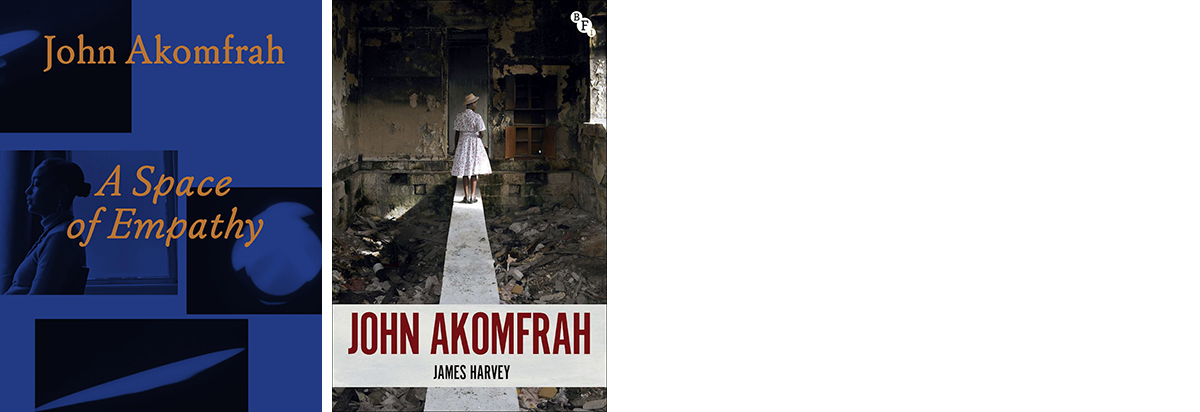
Last fall, two new books on the British artist and filmmaker John Akomfrah have been published. A co-founder of the influential London-based Black Audio Film Collective (established in 1982), Akomfrah will represent the UK at this year’s Venice Biennale. Published by Archive Books and Schirn Kunsthalle Frankfurt on the occasion of the exhibition running at the latter institution until the end of this month, John Akomfrah: A Space of Empathy presents an overview of his work with contributions by the curator Julia Grosse and the co-editor, cultural and media theorist and political activist Nelly Y. Pinkrah, an interview with Akomfrah, along with a foreword by the director of the Schirn Sebastian Baden. The eponymous exhibition has a reading room which can be accessed free of charge, even without a ticket, and includes books from Akomfrah’s own library.
Published by the British Film Institute (BFI), John Akomfrah presents itself as the first comprehensive analytic engagement with these films. The London film scholar James Harvey analyses and negotiates the contextual and theoretical layers of Akomfrah’s rich and complex films, from the intermedial diaspora aesthetics of Handsworth Songs (1986) to the intersectional spatial ecopolitics of Purple (2017). Positioning Akomfrah in the burgeoning Black British arts and cultural scene of the 1980s as a member of Black Audio Film Collective, Harvey traces the evolution of a critical relationship with the postcolonial archive in his early films through analysis of documentaries made for television in the 1990s and up to more recent film installations in museums and galleries.
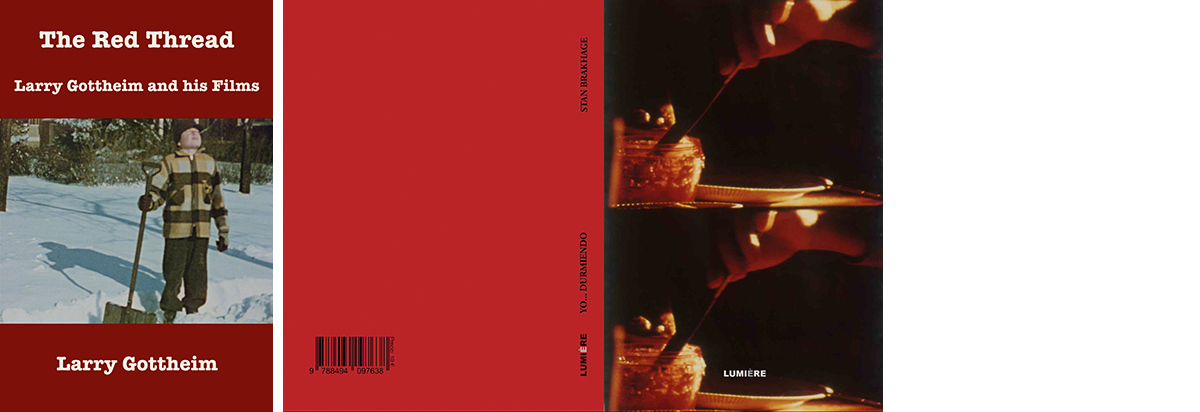
In March 2022, the American avant-garde filmmaker Larry Gottheim (1936) presented a film program and an excerpt from his new book on Ultra Dogme. The book was then already completed but he was still on the lookout for a publisher. Fortunately, he found a home at Eyewash Books that will release The Red Thread: Larry Gottheim and his Films this month. Although best known for his early shorts, Fog Line (1970) in particular, there is a dense undertow of entirely different aesthetic sensibilities. In the book, Gottheim shares his reflections on the evolution of his work over the decades. His own account of his lifelong exploration of the boundaries of cinematic perception is combined with the reflections of other film artists and critics on his work, such as Jonas Mekas, Scott MacDonald, Michael Sicinski, Steve Anker, Heinz Emigholz and others.
The wonderful people of Lumière also fulfilled a longtime dream with their first publication of a book by Stan Brakhage. Pablo Marín translated I . . . . Sleeping (Being a Dream Journal and Parenthetical Explication). Originally published in 1988, this slender volume assembles Brakhage’s notes on his dreams for the months of February through May 1975, a period in his life when he resolved not to release any new films. Edited by Francisco Algarín Navarro, Yo . . . durmiendo (Un diario de sueños y explicaciones entre paréntesis) will be available from the beginning of this month.
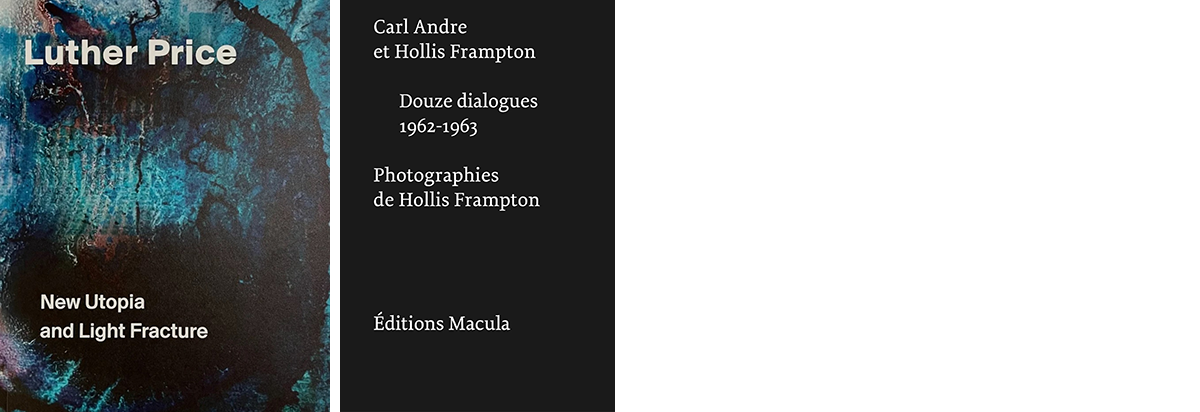
Ed Halter, the founder of Light Industry, famously called Luther Price “Brakhage after punk” and Brakhage himself cited the American experimental filmmaker and visual artist as a personal favorite. Luther Price (1962-2020) donated two sets of handmade 35 mm slides to the Visual Studies Workshop archives in Rochester, New York, in 2017. Including an introduction by Ed Halter who was a close friend of Price, New Utopia and Light Fracture is a posthumous work made from the slides and interspersed email messages from the filmmaker to VSW Press over a period of two years. The messages reveal aspects of Price’s personal history, philosophies and aesthetic principles, domestic and mental states, his sense of humor, as well as fragmented fictions. A first printing edition of 250 copies was released last month.
Another artists correspondence accompanied by images can be found in Carl Andre, Hollis Frampton: Douze dialogues, 1962-1963. In 1962-1963, two aspiring artists took turns in front of a typewriter, they began a dialogue. Hollis Frampton had not yet taken up experimental film and was a photographer at the time. His friend Carl Andre was not yet the minimalist sculptor. Painting, sculpture, photography, cinema, but also music, literature and poetry are the subject of their argumentative contests. Through twelve dialogues, we see their philosophy of art outlined. Originally published in 1980 by the art historian Benjamin Buchloh (PDF), they are here translated in their entirety and supplemented by an afterword.
This book is available since last April from Éditions Macula.
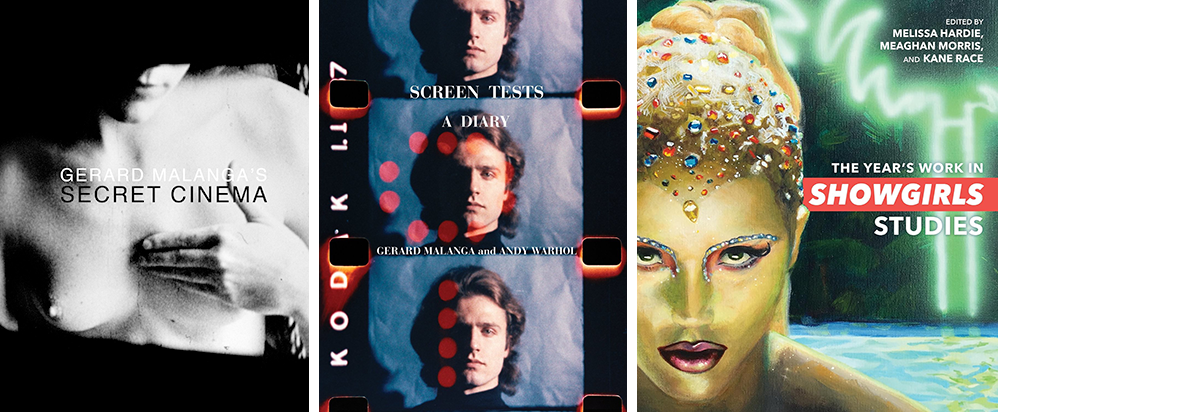
One of the most important poets and photographers of his generation, Gerard Malanga (1943) was Andy Warhol’s chief assistant and collaborator, but during this period he also created a large body of his own movies which remain largely unseen to this day. Many of Malanga’s films were shot at Andy Warhol’s Silver Factory and capture notable moments with visitors like Salvador Dalí, Jack Smith, Donovan and Bob Dylan. In 2012, the editor and archivist Dagon James, with Malanga, set out to create the definitive monograph of his movies. Gerard Malanga’s Secret Cinema documents nearly every movie he created from 1964-1970 with detailed film notes by Malanga himself. Forthcoming in the spring from the Waverly Press, this release will not be widely distributed through stores and is limited to just 250 individually numbered copies, each hand signed by Malanga himself.
Accompanying this publication, an updated version of Screen Tests/A Diary will have a limited release, exclusive to the publisher’s website. This long out of print 1967 book by Gerard Malanga and Andy Warhol pairs fifty-three Screen Tests with poems by Malanga and a new introduction by him in this reissued edition. Some of the subjects in the book include Allen Ginsberg, Lou Reed, Edie Sedgwick, Nico, Jonas Mekas, Paul Morrissey among others. This publication took nearly twelve years to complete. The new printing is based on scans from the original films in Malanga’s archive.
More camp with The Year's Work in Showgirls Studies, published last month by Indiana University Press, although only one of the contributions explicitly plays the card of the camp and queer aspect of Paul Verhoeven’s 1995 cult classic. The collection orchestrates a conversation between scholarly essay work and archival documentation offering a representation of the array of responses generated by the film, its makers, its promoters and its audience, mainly from the perspective of sexuality, race and gender. The book includes a chapter by Adrian Martin and the extensive critical roundtable discussion on Showgirls in Film Quarterly twenty years ago.
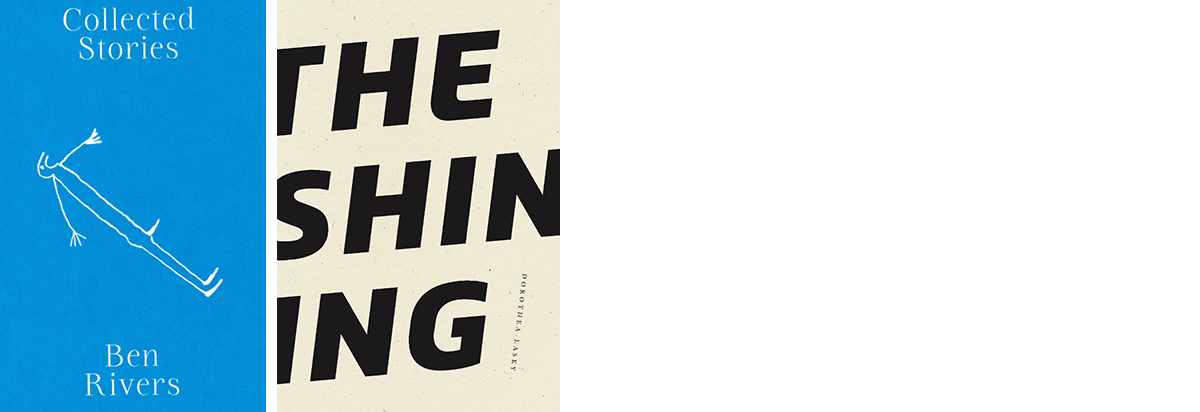
On the occasion of the retrospective Ghost Strata, and Other Stories, held at Jeu de Paume in Paris in November 2023, the British artist and filmmaker Ben Rivers decided to bring his films in conversation with writers who have influenced him over the years. Rivers invited fourteen authors to watch one of his films and respond in writing in any way they wished, resulting in imaginative and surprising fables, essays and poems by Nathalie Léger, Iain Sinclair and others. Collected Stories was published last month from Fireflies Press with the support of STUK: House for Dance, Image and Sound in Leuven, Belgium.
In the meantime, Fireflies Press also revealed the five remaining titles in the Decadent Editions – their series of ten books about ten films, one for each year of the 2000s. Christine Smallwood’s La Captive (Chantal Akerman, 2000) will be the first of these in March, followed by K. Austin Collins’s Domestic Violence (Frederick Wiseman, 2001), Anwen Crawford’s Morvern Callar (Lynne Ramsay, 2002), Ed Halter’s At Sea (Peter Hutton, 2007) and J. Hoberman’s Disorder (Huang Weikai, 2009).
Adopting an approach akin to that of Ben Rivers’s initiative with Collected Stories, Dorothea Lasky’s The Shining is a collection of poems written in response to the homonymous story. As labyrinthine as its namesake, the book is an ekphrastic horror lyric that shapes a unique feminist psychological landscape. Lasky guides us through the familiar rooms of the Overlook Hotel, both realized and imagined, inhabiting characters and spaces that have been somewhat flattened in Stephen King’s novel or Stanley Kubrick’s film adaptation. Ultimately, her poems point us to the ways in which language is always haunted – by past selves, poetic ancestors, and paradoxical histories. Dorothea Lasky (1978) lives in New York where she teaches poetry at Columbia University School of the Arts. The Shining was published last October by Wave Books.
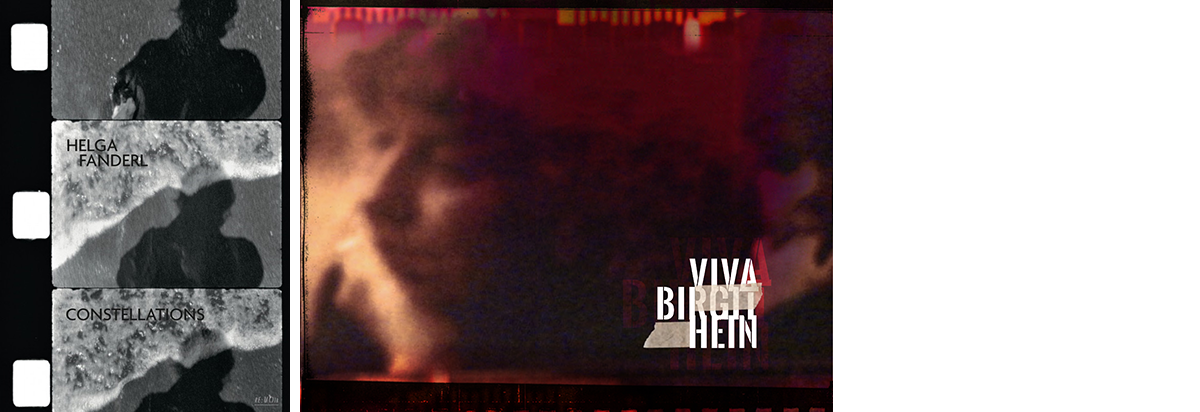
Last November, Re:Voir released Constellations, a DVD containing fifty Super 8 films by Helga Fanderl, digitized and restored in 2023 under her supervision. The DVD comes with the option of a randomized set list, but also includes a fifty-two-page bilingual booklet (EN/FR) with texts by yann beauvais, Laura Staab and Shai Heredia. Constellations should not be confused with Konstellationen Super 8, the collection (EN/FR/DE) that appeared earlier this year from Hatje Cantz, announced in our spring overview.
The godmother of German experimental film, Birgit Hein (1942-2023) is celebrated in a new publication that was made available as a free PDF download. Viva Birgit Hein is a 350-page dossier of collected interviews, writings on and by Hein, labor-of-love-commissioned articles on particular works of hers, as well as reprints of reviews and historic documents. In the introduction, the Canadian experimental filmmaker Mike Hoolboom who edited the book, writes: “This is a collection of love letters from friends and familiars. We needed to hear her voice again. New writings abound and because the fringe remains an oral culture there are recordings of after-screening conversations.” The book was presented at Arsenal in Berlin on November 30.
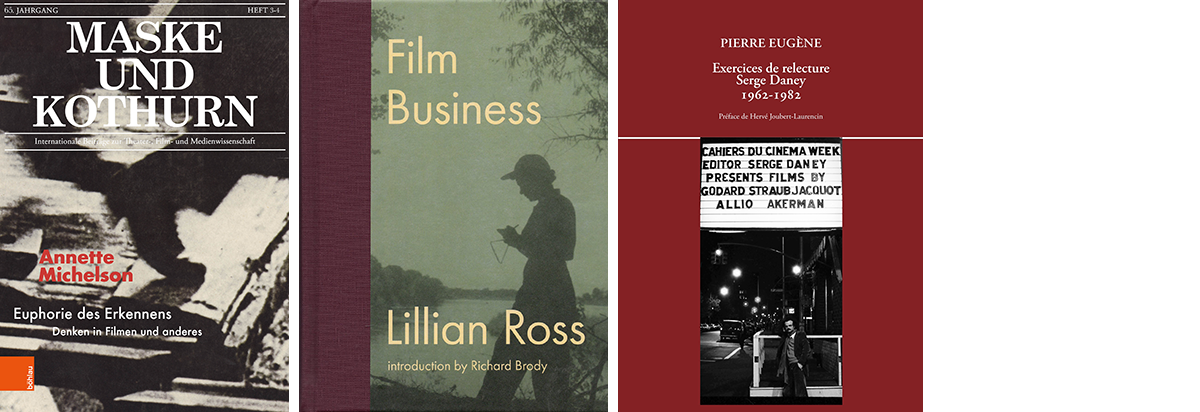
Last November, a new collection of writing by the late critic, scholar and cofounder of October Annette Michelson was presented at the Austrian Film Museum in Vienna. Annette Michelson. Denken in Filmen und anderes brings together for the first time in German the central texts from the two volumes On the Eve of the Future (2017) and On the Wings of Hypothesis (2020) recently published by MIT Press, as well as early and smaller works and an unpublished conversation with Alexander Kluge translated by Ted Fendt.
The work of another New York woman film writer has been gathered in Film Business: Lillian Ross. A pioneer of the narrative “new journalism,” Lillian Ross was a staff writer at The New Yorker for seven decades. The collection includes pieces on Kurosawa, Truffaut, Godard, Huston, Tati, Chaplin, Hitchcock, Eastwood, Fellini, Gene Kelly and Cassavetes among others. Ross “recognized, from early in her career, that the center of gravity in the world of movies is indeed the director,” notes The New Yorker’s Richard Brody in his introduction of this publication by Film Desk Books.
We first announced Pierre Eugène’s Exercices de relecture – Serge Daney, 1962-1982 in our book notes as early as September last year. We want to include it here again with its cover. The film critic and teacher Pierre Eugène writes: "I conceived my book as a way of rereading Daney in the movement (dans le mouvement), as close as possible to the activity of his shifting and changing thinking, its contexts, references and echoes. It’s a rather meticulous, chronological analysis of almost all his texts from the 1962-1982 period, illuminated by private writings (seventy-five notebooks and 1,800 postcards to his mother, to which I had access thanks to the Bonaud family), which I mention at length, and you’ll even find a few reproductions that punctuate the work, among other photograms and cinephilic fetishes.” Published by Éditions du Linteau last November, Pierre Eugène presented the book at Cinema L’Archipel in Paris on December 10.
Please take note that together with Kate Ince and Marc Siegel, Pierre Eugène is also one of the co-editors of Serge Daney and Queer Cinephilia, an English-language open-access and print collection of new essays investigating the contemporary relevance of Daney’s work with a particular interest in questions of feminist, queer and digital cinephilia. The publication originates from their homonymous research project that started in 2018 and was funded through the AHRC’s Research Network scheme. Forthcoming from meson press in the Configurations of Film series, the publication is announced for early this year. You can find the full table of contents here.
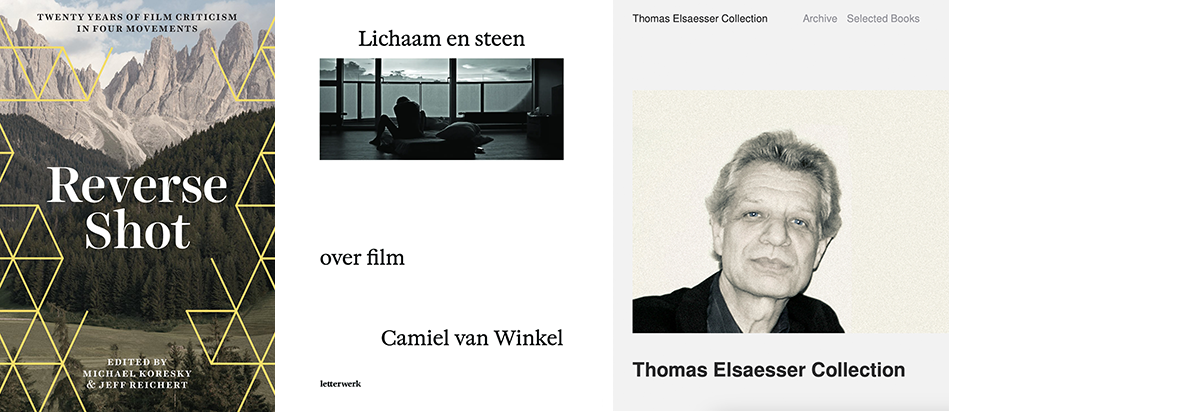
With the Thomas Elsaesser Collection, another open-access project has become available online since October. The pioneering film scholar, who passed away in 2019, entrusted his research archive, consisting of more than four hundred boxes of documents, books, videotapes, as well as digital files, with the German Film Museum (DFF). The DFF is now gradually making this intellectual legacy available online on its own dedicated website. The foundations of the project were laid by Elsaesser himself during his lifetime and the DFF has sought to be in keeping with its spirit. At its launch, the website publishes a broad selection of texts from Elsaesser’s bibliography spanning more than four decades, covering topics from early cinema to media archaeology to New German Cinema. His groundbreaking monograph on Rainer Werner Fassbinder is made accessible in its entirety. In the ensuing months and years, more materials from his archive and extensive bibliography will be published online.
Back to the film criticism anthologies. To celebrate the twentieth anniversary of the film journal Reverse Shot, New York’s Museum of the Moving Image has published a special anthology which collects central pieces from the journal’s beginnings up through the latest releases. Originally printed as a stapled zine, distributed for free throughout New York, the independent film journal began in 2003 as a labor-of-love endeavor among a small group of twenty-something cinephiles. Among them were Michael Koresky and Jeff Reichert who still edit the journal and also edited the publication. You can buy Reverse Shot: Twenty Years of Film Criticism in Four Movements exclusively from Museum of the Moving Image’s online shop or in the Museum's store on-site.
Writing on film for many years, mainly for the Dutch-language art magazine De Witte Raaf, the art historian and teacher Camiel van Winkel (1964) collected seven film essays in Lichaam en steen. Over film. With an eye trained in contemporary art and dance, van Winkel looks at films by directors as diverse as Steve McQueen and Nicolas Provost, Ursula Antoniak and Michael Haneke, Tobe Hooper and Ilya Chrzjanovski, Lars von Trier and Chantal Akerman, Gus Van Sant and Erik Poppe. An important theme is self-destructive or relational violence, but also the way in which human desires manifest themselves in a choreography of moving bodies through urban structures of steel, stone and concrete. Published by Letterwerk, this collection was launched last October at WIELS, Brussels.
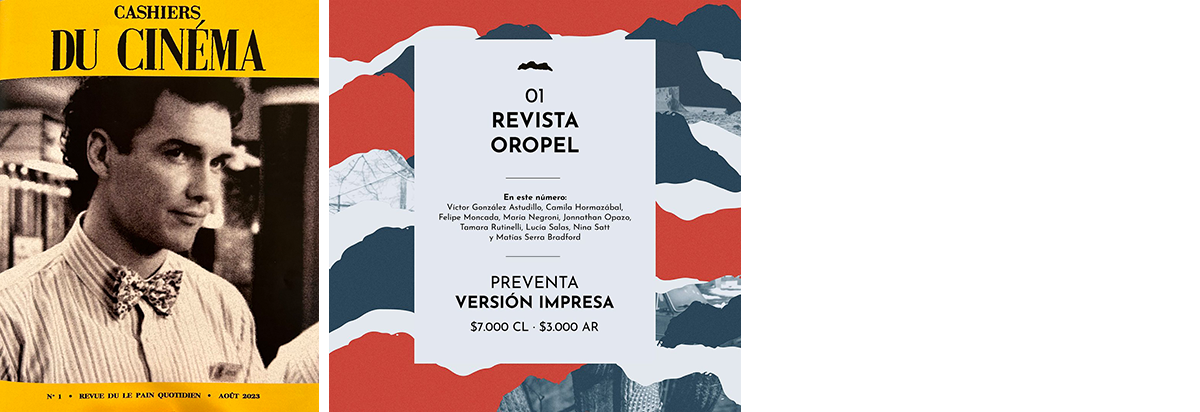
Cashiers du Cinéma is a forty-page risograph zine published by and consisting entirely of creative works by some twenty cinema workers past and (mostly) present. The first issue contains art, comics, interviews, personal essays, short fiction and much more, all about the love-hate relationship they have working in movie theaters, including caricatures of favorite New York cinephiles. Copies can be found in Manhattan at Codex Books, Paradise of Replica and Village Works, Book Thug Nation in Williamsburg or Desert Island in Brooklyn, but it’s also up for sale online at Obvious Fake Press. Last November, a second print was made available with a bonus mini zine inside. Meanwhile, the real Cahiers du cinema dedicated its second Hors-série issue to the work of David Lynch.
Last November, Revista Oropel launched its first print issue at La Cafebrería in Santiago de Chile. Revista Oropel was founded six years ago as an (online) magazine of literature, cinema, art and photography. In the inaugural print edition, the critic Lucía Salas has written a text on Ida Lupino’s Outrage (1950), the film that was screened at the launch event.
2023 also saw the launch of a new online film journal Lucky Star, named after the 1929 Frank Borzage picture, “a masterpiece which abandons the rational in its pursuit of beauty and emotion,” as the editors Seema Pai, Nathan Rogers Hancock and Jhon Hernandez state in the presentation of this new space. “Contemporary film culture could use more of this passion, more of this abandon, when speaking about films,” they continue. “If one looks at the yearly roundups on film websites it becomes obvious – everyone is seeing the same movies, going to the same festivals. In short, there are no discoveries.”
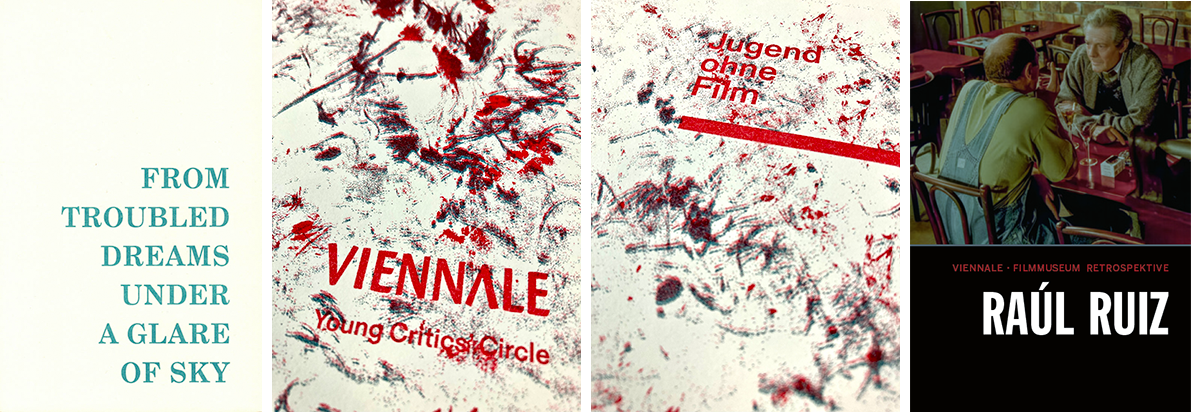
After its last edition, the Jeonju International Film Festival published Jeonju Cinema Project: Ten Years Dreaming of a Festival as a Producer. This print publication traces the history of this project to invest in thirty-three domestic and international independent and art films, but also includes reviews of the selected works by all-female critics.
The culminating project of the Edinburgh International Film Festival’s Critical Writing Commissions program, From Troubled Dreams Under A Glare Of Sky is a new collection of texts from nine writers in Scotland on films in the EIFF 2023 program. Filmmakers discussed include Kelly Reichardt, Cauleen Smith, Celine Song and Paul B. Preciado, among others. The book has been edited by Michael Pattison.
A similar initiative took place at the Viennale, last October. For the first time the festival hosted a Young Critics’ Circle. Under the editorial and organisational guidance of the author and film critic Patrick Holzapfel, an extra issue of Jugend ohne Film was published with the texts of the Young Critics Laura Staab, Luise Mörke, Ariadna Solera Centeno and Victor Morozov. It also includes twelve texts on Raúl Ruiz whose work was the subject of a retrospective at the festival. This special edition concludes with a correspondence on essayistic film writing – the theme of the workshop – between Holzapfel and Aaron Cutler.
Accompanying this Raúl Ruiz retrospective at the Viennale and the Austrian Film Museum, the English-language catalogue publication Raúl Ruiz features texts for every of the forty films that were shown. The collection contains commentaries by Raúl Ruiz himself in the form of interviews and descriptions of his films. There is also an essay by Adrian Martin, who has long studied Ruiz’s work, and a text on his writing practice by Bruno Cuneo who manages Ruiz’s written archive, an unpublished transcript and much more. No one else than Raúl Ruiz understood better that the end is the beginning is the end.

